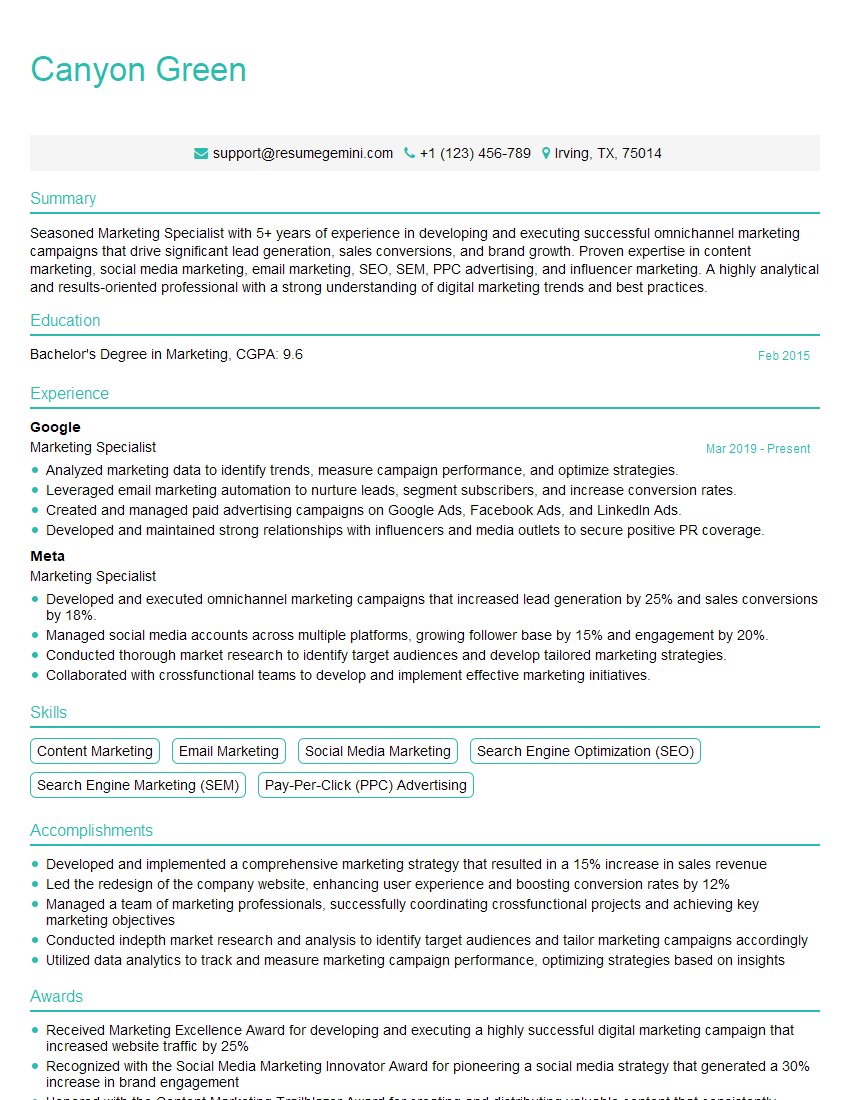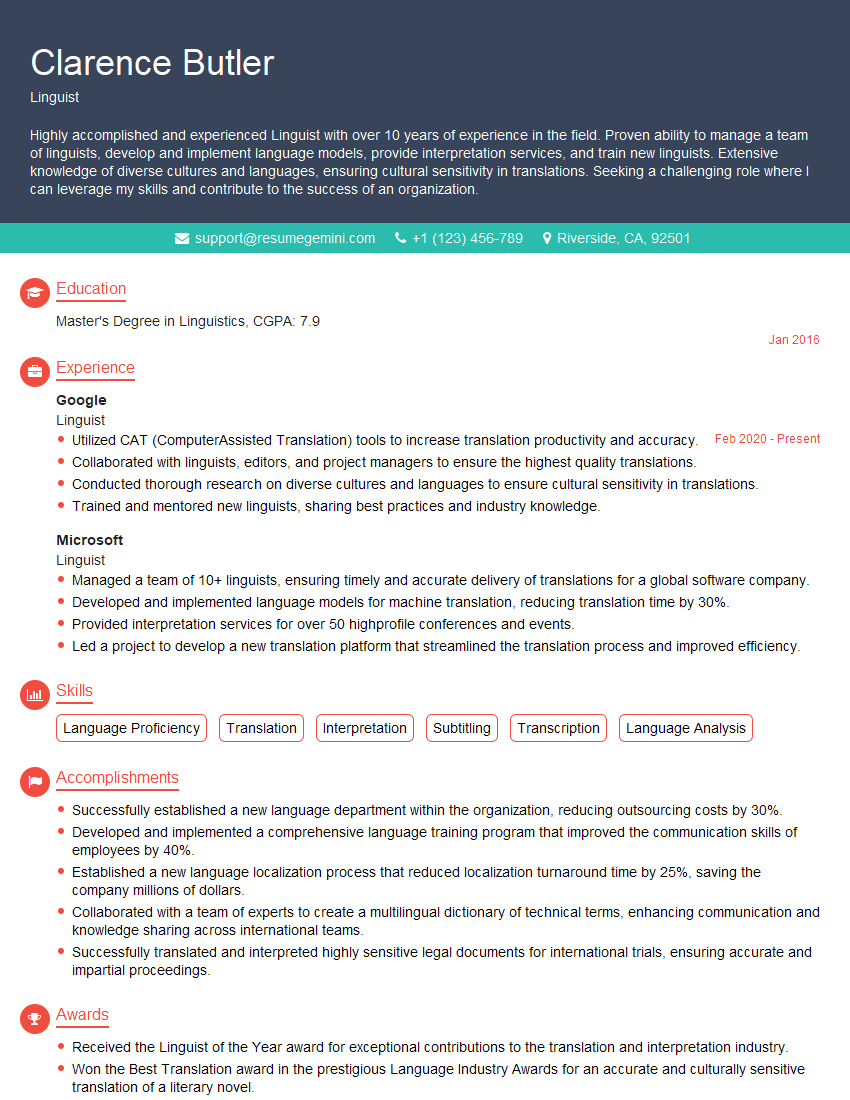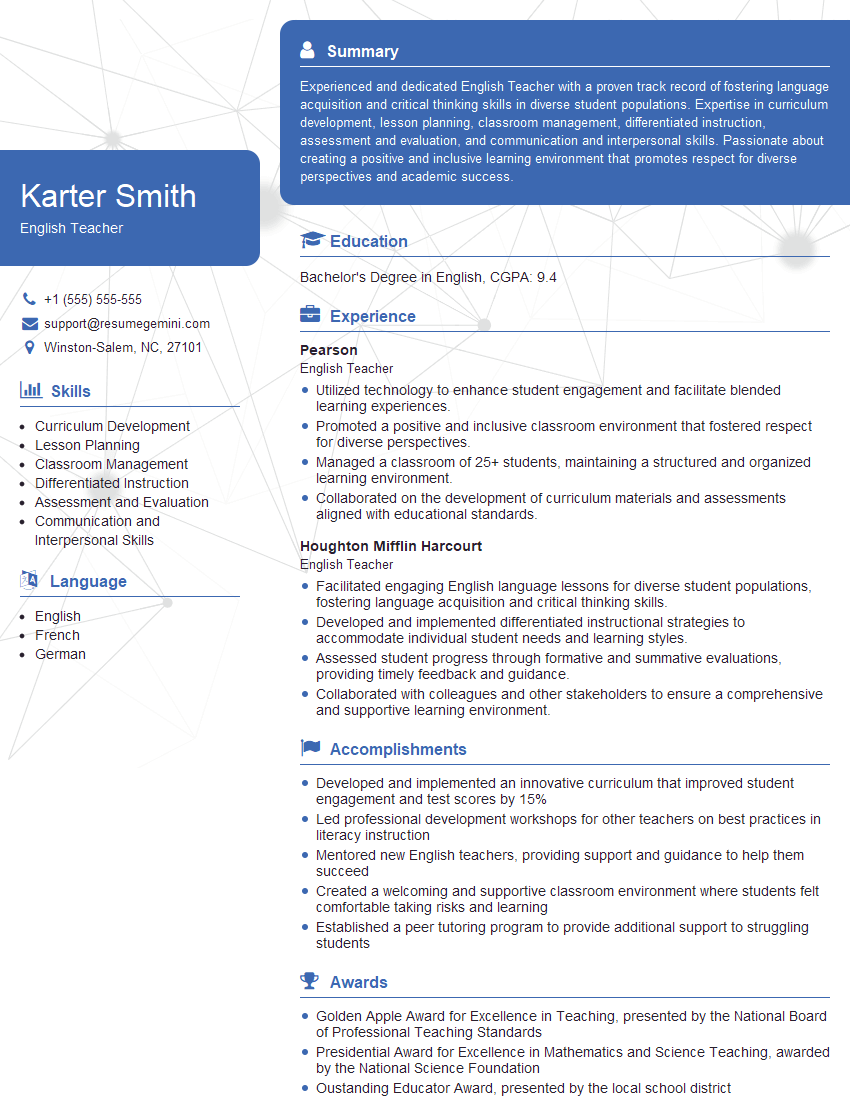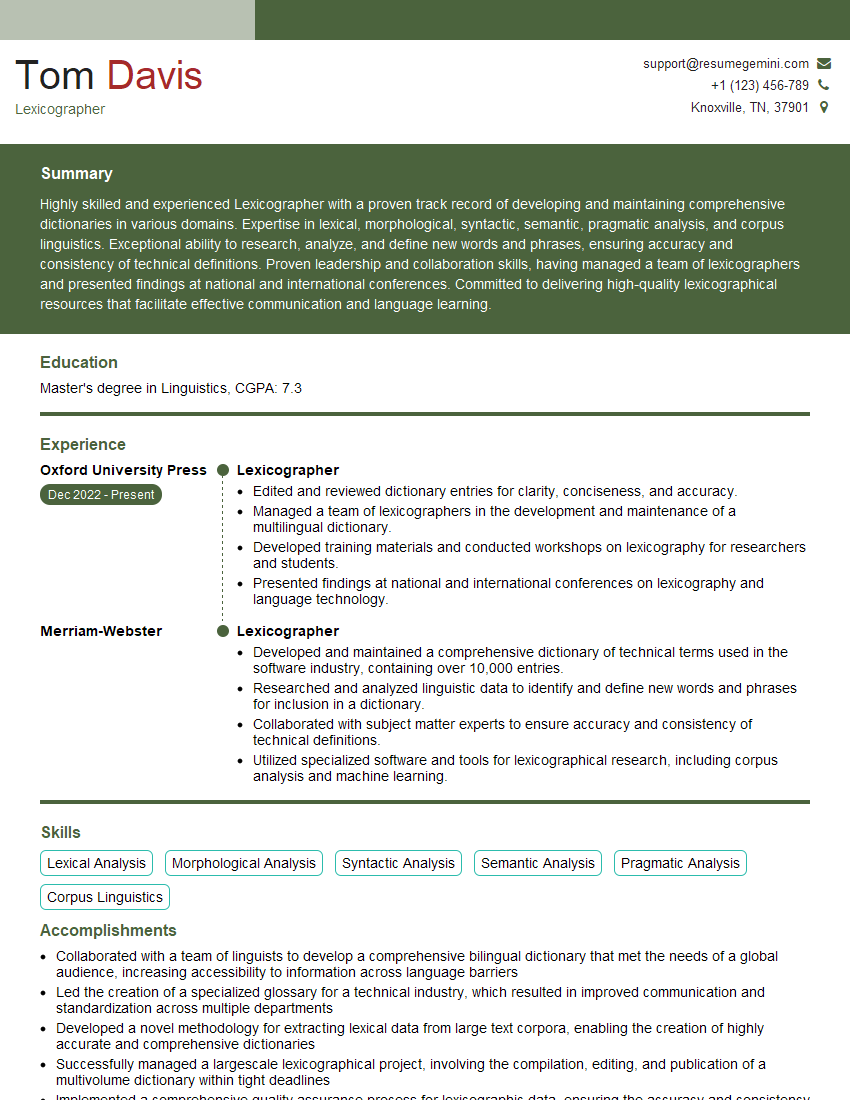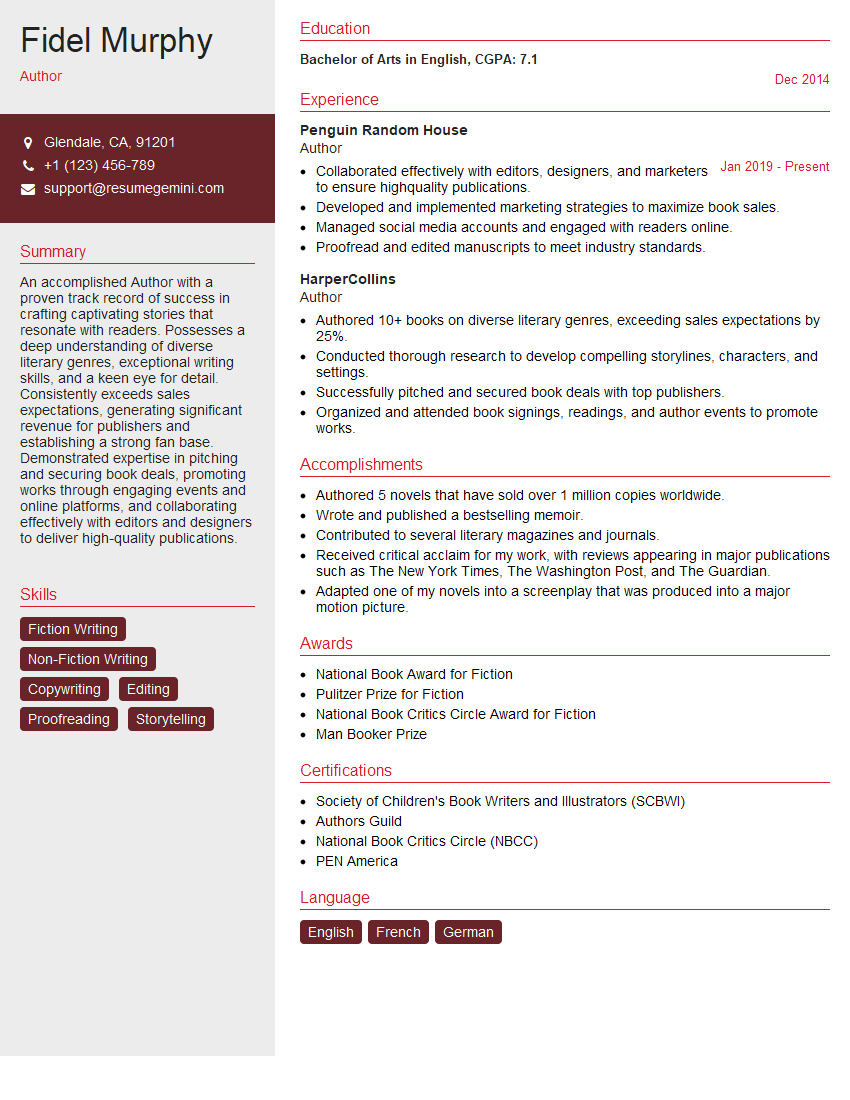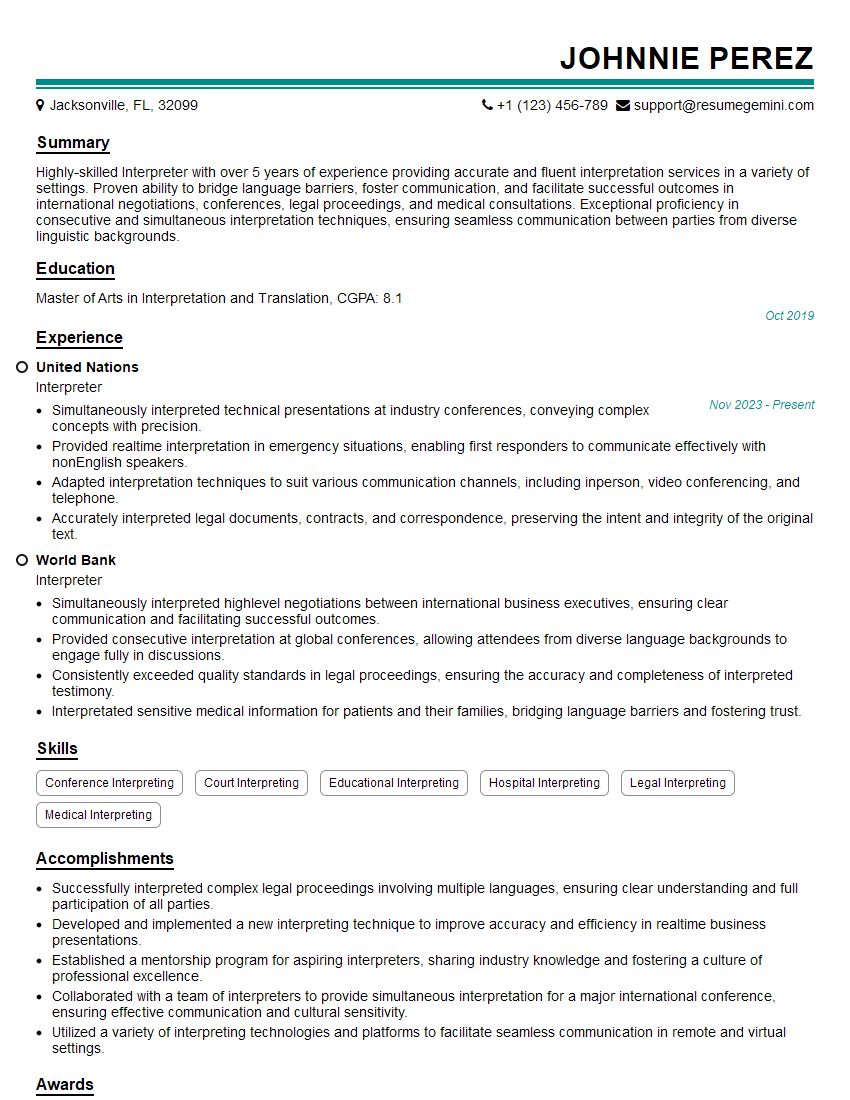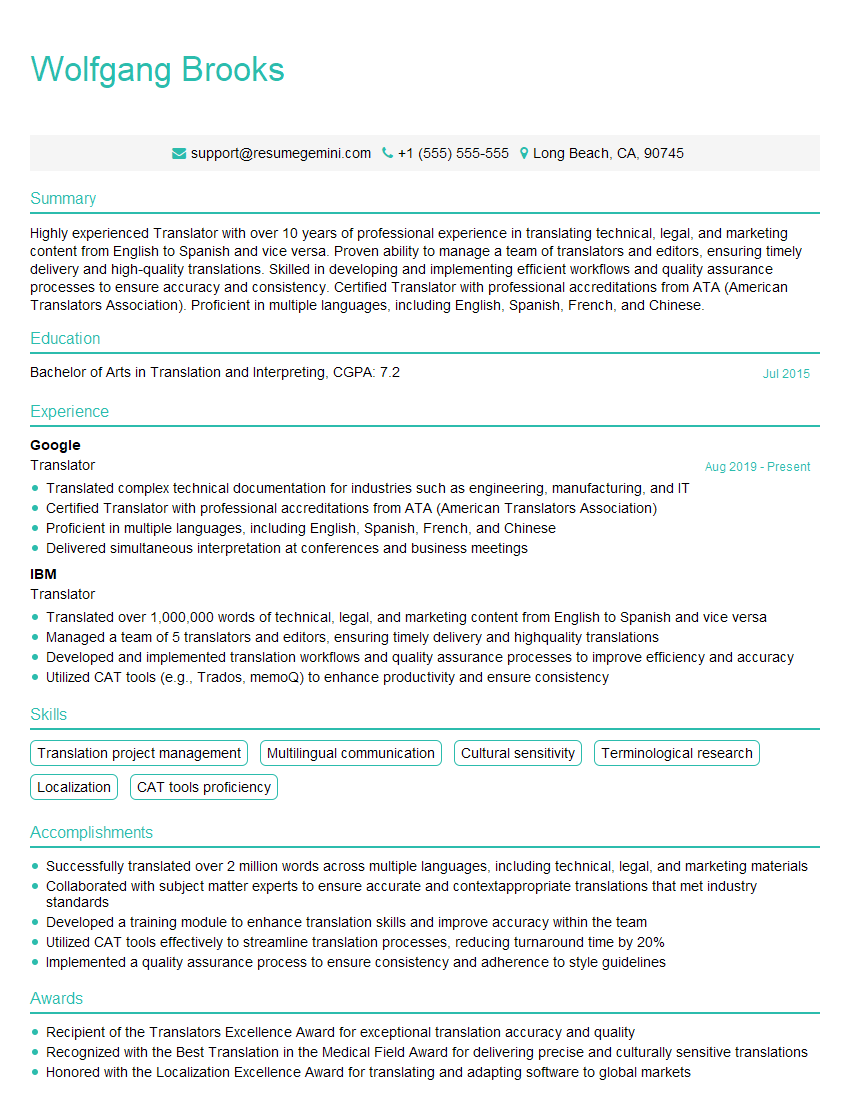Are you ready to stand out in your next interview? Understanding and preparing for Strong understanding of English language and grammar interview questions is a game-changer. In this blog, we’ve compiled key questions and expert advice to help you showcase your skills with confidence and precision. Let’s get started on your journey to acing the interview.
Questions Asked in Strong understanding of English language and grammar Interview
Q 1. What is the difference between a phrase and a clause?
The core difference between a phrase and a clause lies in their completeness as grammatical units. A phrase is a group of related words that lacks both a subject and a verb. It functions as a single unit within a sentence, acting as a noun, adjective, or adverb. Think of it as a fragment of a complete thought. A clause, on the other hand, contains both a subject (the actor) and a verb (the action). It expresses a complete thought, though it might not be a complete sentence on its own. A clause can be independent (a complete sentence) or dependent (requiring an independent clause to form a complete sentence).
- Phrase Example: “the fluffy cat” (noun phrase); “running quickly” (participial phrase); “with great enthusiasm” (prepositional phrase)
- Clause Example: “The cat slept.” (independent clause); “because the cat was tired” (dependent clause)
Imagine a sentence as a house. Phrases are like individual rooms – essential parts but not a whole house on their own. Clauses are like complete apartments – they have everything needed to stand independently.
Q 2. Explain the difference between active and passive voice.
Active voice describes a sentence where the subject performs the action. The subject is the doer of the verb. Passive voice, conversely, reverses this structure. The subject receives the action instead of performing it. The actor is often omitted or placed later in the sentence using a “by” phrase.
- Active Voice Example: “The dog chased the ball.” (The dog is the subject doing the chasing)
- Passive Voice Example: “The ball was chased by the dog.” (The ball is the subject receiving the action of chasing)
Active voice is generally preferred in professional writing because it’s more direct, concise, and engaging. Passive voice can be useful when the actor is unknown, unimportant, or deliberately omitted for emphasis, but overuse can make writing sound weak and indirect. For instance, in scientific reports, passive voice might be used to emphasize the results rather than the researcher who obtained them: “The experiment was conducted…”
Q 3. Identify and correct the grammatical errors in the following sentence: ‘Me and my friend went to the store.’
The sentence “Me and my friend went to the store” contains a pronoun case error. The correct sentence is: “My friend and I went to the store.”
The pronoun “me” is in the objective case, used when the pronoun receives the action. The subject of the sentence—who is performing the action of going—requires the nominative case, “I.” Further, it’s generally considered more polite to place the other person first in a list of subjects.
Q 4. What are the four main types of sentence structures?
The four main types of sentence structures are based on the number and type of clauses they contain:
- Simple Sentence: Contains one independent clause (one subject and one verb). Example:
The cat sat on the mat. - Compound Sentence: Contains two or more independent clauses, usually joined by a coordinating conjunction (e.g., and, but, or, nor, for, so, yet) or a semicolon. Example:
The cat sat on the mat, and the dog slept on the rug. - Complex Sentence: Contains one independent clause and one or more dependent clauses. Example:
Because it was raining, the cat stayed inside. - Compound-Complex Sentence: Contains two or more independent clauses and one or more dependent clauses. Example:
Although it was raining, the cat went outside, and the dog followed him.
Understanding sentence structures helps writers vary their sentence style, creating more engaging and readable text. Monotonous sentence structures can bore the reader, while a varied approach keeps the writing lively and interesting.
Q 5. Define subject-verb agreement and provide an example.
Subject-verb agreement means that the verb in a sentence must agree in number (singular or plural) with its subject. If the subject is singular, the verb must also be singular; if the subject is plural, the verb must be plural. This principle ensures grammatical correctness and clarity.
- Example (Singular):
The dog barks loudly.(singular subject “dog” and singular verb “barks”) - Example (Plural):
The dogs bark loudly.(plural subject “dogs” and plural verb “bark”)
Subject-verb agreement can be tricky with collective nouns (e.g., team, family), which can be treated as singular or plural depending on the context. For example: “The team is playing well” (team as a unit) vs. “The team are arguing amongst themselves” (team as individual members).
Q 6. Explain the use of commas in a complex sentence.
Commas play a crucial role in complex sentences, primarily in separating independent and dependent clauses. In a complex sentence with a dependent clause preceding the independent clause, a comma is typically used to separate the two. If the dependent clause follows the independent clause, a comma is often, but not always, necessary. The presence or absence of the comma often influences the emphasis and the reading rhythm of the sentence.
- Example (Dependent clause first):
After the rain stopped, the sun came out.(comma separates the dependent clause “After the rain stopped” from the independent clause “the sun came out”) - Example (Independent clause first – comma optional):
The sun came out after the rain stopped.(comma is optional here. The sentence is grammatically correct with or without the comma, though the comma improves readability).
Incorrect comma usage in complex sentences can lead to confusion or misinterpretations. Understanding comma rules ensures clarity and enhances the overall effectiveness of your writing.
Q 7. What are the different types of pronouns, and how are they used?
Pronouns are words that replace nouns, avoiding repetition and making writing more concise and fluid. There are several types:
- Personal Pronouns: Refer to specific people or things (e.g., I, me, you, he, him, she, her, it, we, us, they, them).
- Possessive Pronouns: Show ownership (e.g., mine, yours, his, hers, its, ours, theirs).
- Reflexive Pronouns: Refer back to the subject of the sentence (e.g., myself, yourself, himself, herself, itself, ourselves, yourselves, themselves).
- Demonstrative Pronouns: Point to specific things (e.g., this, that, these, those).
- Interrogative Pronouns: Used to ask questions (e.g., who, whom, whose, which, what).
- Relative Pronouns: Introduce relative clauses (e.g., who, whom, whose, which, that).
- Indefinite Pronouns: Refer to non-specific people or things (e.g., anyone, everyone, someone, no one, anybody, everybody, somebody, nobody, anything, everything, something, nothing).
Correct pronoun usage is essential for clear and grammatical writing. Misusing pronouns can lead to ambiguity and grammatical errors. Paying attention to pronoun case (nominative, objective, possessive) and ensuring pronoun-antecedent agreement (pronoun agrees with the noun it replaces) are crucial aspects of proper grammar.
Q 8. Explain the difference between a participle and a gerund.
Participles and gerunds are both verb forms ending in -ing, but they function differently in a sentence. A participle acts as an adjective, modifying a noun or pronoun. A gerund, on the other hand, acts as a noun, functioning as the subject, object, or complement of a verb.
Think of it this way: participles describe, while gerunds do.
- Participle Example: The running water cascaded down the mountain. (Running describes the water.)
- Gerund Example: Running is my favorite form of exercise. (Running is the subject of the sentence.)
Identifying the function within the sentence is key: if it modifies a noun, it’s a participle; if it acts like a noun, it’s a gerund.
Q 9. How do you identify and correct dangling modifiers?
A dangling modifier is a phrase or clause that doesn’t clearly modify any specific word in the sentence, leading to ambiguity or illogical meaning. To identify them, look for introductory phrases followed by a sentence where the subject doesn’t logically connect to the action described in the phrase.
Example of a dangling modifier: After finishing my homework, the television was turned on. (It sounds like the homework turned on the TV!)
Correction: After finishing my homework, I turned on the television.
Steps to Correct:
- Identify the introductory phrase: Pinpoint the phrase that seems to be modifying something incorrectly.
- Locate the intended subject: Determine which noun or pronoun the phrase *should* modify.
- Rewrite the sentence: Place the intended subject as close as possible to the introductory phrase to clarify the relationship.
In professional writing, clear sentence structure is paramount. Dangling modifiers undermine clarity and professionalism.
Q 10. What are the different types of adverbial clauses?
Adverbial clauses modify verbs, adjectives, or other adverbs, providing additional information about time, place, reason, condition, purpose, contrast, or concession. They are often introduced by subordinating conjunctions.
- Adverbial Clause of Time: After the rain stopped, we went for a walk. (indicates when)
- Adverbial Clause of Place: We picnicked where the river flows. (indicates where)
- Adverbial Clause of Reason: I stayed home because I was sick. (indicates why)
- Adverbial Clause of Condition: If it snows tomorrow, school will be canceled. (indicates under what condition)
- Adverbial Clause of Purpose: He studied hard so that he could pass the exam. (indicates the goal)
- Adverbial Clause of Contrast/Concession: Although it was cold, we went swimming. (indicates contrast/concession)
Understanding the different types helps create varied and nuanced sentences, essential for sophisticated writing.
Q 11. Explain the concept of parallel structure and give an example.
Parallel structure, also known as parallelism, means using the same grammatical structure for items in a list or series. It ensures balance and clarity in writing.
Example of Incorrect Parallelism: She enjoys swimming, to bike, and hiking.
Example of Correct Parallelism: She enjoys swimming, biking, and hiking. (All three items are gerunds)
Another Example: He is intelligent, hardworking, and a dedicated employee.
Corrected Example: He is intelligent, hardworking, and dedicated. (All three are adjectives)
In professional contexts, parallel structure enhances readability and strengthens arguments by presenting information in a consistent and logical manner. Ignoring it leads to awkward and potentially confusing sentences.
Q 12. What are the different types of conjunctions?
Conjunctions connect words, phrases, or clauses. They’re categorized into coordinating, subordinating, and correlative conjunctions.
- Coordinating Conjunctions: Connect words, phrases, or clauses of equal grammatical rank (FANBOYS: for, and, nor, but, or, yet, so).
- Subordinating Conjunctions: Introduce dependent clauses and show their relationship to the main clause (e.g., because, although, since, if, unless, while, after, before).
- Correlative Conjunctions: Work in pairs to connect items of equal grammatical rank (e.g., both…and, either…or, neither…nor, not only…but also).
Proper conjunction use builds strong sentence relationships, improving the overall flow and coherence of your writing.
Q 13. Define ‘appositive’ and provide an example.
An appositive is a noun or noun phrase that renames or explains another noun or pronoun immediately preceding it. It adds extra information without changing the sentence’s core meaning.
Example: My friend, a talented musician, played the violin beautifully. (a talented musician renames My friend).
Appositives provide context and details, making writing more engaging and informative. They’re a valuable tool for enhancing clarity and precision.
Q 14. How do you use semicolons correctly?
Semicolons (;) connect two closely related independent clauses (complete sentences that could stand alone) without using a coordinating conjunction. They can also separate items in a list that already contains commas.
Correct Usage: The rain poured heavily; the streets flooded.
Incorrect Usage: The rain poured heavily; and the streets flooded.
List with Semicolons: I’ve traveled to Paris, France; Rome, Italy; and London, England.
Overusing semicolons can make writing appear cluttered. Use them judiciously to enhance sentence structure and clarity, avoiding unnecessary complexity.
Q 15. What are the different types of punctuation marks and their uses?
Punctuation marks are vital for conveying meaning and structure in writing. They act like traffic signals, guiding the reader through your sentences and paragraphs. Here are some key types and their uses:
- Period (.): Indicates the end of a declarative sentence.
Example: The cat sat on the mat. - Question Mark (?): Indicates the end of an interrogative sentence.
Example: Did you see the cat? - Exclamation Mark (!): Expresses strong emotion or emphasis.
Example: The cat is HUGE! - Comma (,): Separates items in a list, clauses in a sentence, and introductory phrases.
Example: I bought apples, bananas, and oranges. - Semicolon (;): Connects closely related independent clauses.
Example: The storm raged; the trees swayed violently. - Colon (:): Introduces a list, explanation, or quotation.
Example: I need three things: milk, eggs, and bread. - Dash (—): Indicates a break in thought or sets off parenthetical information.
Example: The dog—a golden retriever—ran towards me. - Apostrophe (‘): Shows possession or contraction.
Example: The cat's toy; It's raining. - Quotation Marks (“): Enclose direct quotes or titles of short works.
Example: She said, "Hello!" - Parentheses (()): Enclose additional information or asides.
Example: The book (published in 1998) is a classic. - Brackets [ ]: Used to insert clarifying information within a quote.
Example: "The play [Hamlet] is Shakespeare's masterpiece."
Mastering punctuation enhances clarity and professionalism in all forms of writing, from emails to academic papers.
Career Expert Tips:
- Ace those interviews! Prepare effectively by reviewing the Top 50 Most Common Interview Questions on ResumeGemini.
- Navigate your job search with confidence! Explore a wide range of Career Tips on ResumeGemini. Learn about common challenges and recommendations to overcome them.
- Craft the perfect resume! Master the Art of Resume Writing with ResumeGemini’s guide. Showcase your unique qualifications and achievements effectively.
- Don’t miss out on holiday savings! Build your dream resume with ResumeGemini’s ATS optimized templates.
Q 16. Explain the difference between ‘its’ and ‘it’s’.
The difference between ‘its’ and ‘it’s’ lies in possession versus contraction. ‘Its’ is the possessive pronoun, showing ownership. ‘It’s’ is a contraction of ‘it is’ or ‘it has’.
- Its: The bird cleaned its feathers. (The feathers belong to the bird)
- It’s: It’s a beautiful day. (It is a beautiful day)
Think of the apostrophe in ‘it’s’ as a stand-in for the missing letters. If you can replace it with ‘it is’ or ‘it has,’ use ‘it’s’. Otherwise, use ‘its’.
Q 17. Explain the difference between ‘their,’ ‘there,’ and ‘they’re’.
These three words are frequently confused, but understanding their distinct meanings is simple. ‘Their’ shows possession, ‘there’ indicates a place, and ‘they’re’ is a contraction.
- Their: That’s their house. (The house belongs to them)
- There: The book is over there. (Indicates a location)
- They’re: They’re going to the park. (They are going to the park)
Remembering the meaning of each word will prevent errors. If you’re unsure, try substituting ‘they are’ for ‘they’re’. If it fits, you’ve got the right word.
Q 18. What are some common grammatical errors to avoid?
Several grammatical errors can hinder clear communication. Here are some common ones to avoid:
- Subject-verb agreement: The verb must agree in number with its subject.
Incorrect: The dogs run fast. (Should be 'runs' if referring to a single dog) - Pronoun agreement: Pronouns must agree in number and gender with their antecedents.
Incorrect: Each student should bring their own book. (Should be 'his or her' or 'their' - the latter is now widely accepted) - Incorrect tense: Maintain consistency in verb tense throughout your writing.
Incorrect: I went to the store and buy milk. (Should be 'bought') - Comma splices: Do not join two independent clauses with only a comma. Use a semicolon, conjunction, or separate them into two sentences.
Incorrect: The sun was shining, it was a beautiful day. - Run-on sentences: Avoid excessively long sentences that lack clear structure. Break them into shorter, more manageable sentences.
- Dangling modifiers: Ensure that modifiers clearly refer to the words they modify.
Incorrect: Walking down the street, the trees were beautiful. (The trees weren't walking!) - Misplaced modifiers: Place modifiers as close as possible to the words they modify.
Incorrect: I saw a dog running down the street with a long tail.
Proofreading carefully and using a grammar checker can help identify and correct these errors.
Q 19. How do you ensure clarity and conciseness in your writing?
Clarity and conciseness are crucial for effective writing. Here’s how to achieve them:
- Use strong verbs and precise nouns: Avoid weak verbs like ‘is’ and ‘are’ when stronger options are available. Replace vague nouns with specific ones.
- Eliminate unnecessary words and phrases: Cut out jargon, clichés, and redundancies. Ask yourself if each word adds value.
- Organize your thoughts logically: Use clear topic sentences and transitions to guide the reader through your ideas.
- Break up long sentences: Short, concise sentences are easier to understand.
- Use active voice whenever possible: Active voice is generally more direct and engaging than passive voice.
Passive: The ball was thrown by the boy. Active: The boy threw the ball.
Regularly revise your work, reading it aloud to identify areas where you can improve clarity and conciseness.
Q 20. Explain the importance of using precise language.
Precise language is vital for accurate and effective communication. Using the right word eliminates ambiguity and ensures your message is understood correctly. Imprecise language can lead to misinterpretations and confusion, especially in professional contexts where clarity is paramount. For instance, instead of saying ‘a lot of people’, specify a number or use a more precise term like ‘a majority’ or ‘a significant number’.
Consider the impact of vague words like ‘good’ or ‘bad’. Replacing them with more descriptive terms adds impact and nuance to your writing. Instead of ‘good performance’, consider ‘exceeded expectations’ or ‘met all targets’.
Q 21. How do you adapt your writing style to different audiences?
Adapting your writing style to different audiences is crucial for effective communication. The same message needs to be tailored depending on who is receiving it. Consider these factors:
- Audience knowledge: Simplify technical terms or jargon for a non-expert audience. For example, a scientific paper requires technical detail, whereas a blog post explaining the same topic might need simplified language.
- Audience purpose: Understand why the audience is reading your work. Are they seeking information, entertainment, or persuasion? This dictates your tone and style.
- Audience formality: Maintain a formal tone for professional audiences and a more relaxed style for friends or colleagues.
- Audience age: Adjust your vocabulary and sentence structure to suit the age and reading level of your audience.
Always put yourself in your audience’s shoes. Imagine yourself as the reader and ask: Is this easy to understand? Is it engaging? Does it fulfill their needs?
Q 22. What is the difference between formal and informal writing?
The difference between formal and informal writing lies primarily in its purpose, audience, and tone. Formal writing is characterized by its precision, objectivity, and adherence to grammatical rules. It’s typically used for academic papers, business reports, legal documents, and official correspondence. Informal writing, on the other hand, is more relaxed, personal, and expressive. It’s common in emails to friends, personal blogs, and casual conversations.
- Formal: Uses complex sentence structures, avoids contractions (e.g., ‘cannot’ instead of ‘can’t’), maintains a neutral tone, and employs a more sophisticated vocabulary. Example: ‘The aforementioned data indicates a significant correlation between the variables.’
- Informal: Uses simpler sentence structures, contractions are common, the tone can be subjective and emotional, and the vocabulary is often less technical. Example: ‘The numbers show a strong link between the things we’re looking at.’
Choosing between formal and informal writing depends entirely on the context. Mismatching the style can lead to misunderstandings and misinterpretations. For example, using informal language in a job application would likely be detrimental, while overly formal language in a personal email might seem stiff and unfriendly.
Q 23. How do you edit and proofread your own work?
My editing and proofreading process is a multi-stage approach, ensuring thoroughness and accuracy. I begin by setting the document aside for a period of time – at least a few hours, ideally a day – to gain some distance from my own writing. This allows for a fresh perspective when I return to it.
Then, I start with a macro-level review, focusing on the overall organization, clarity, and flow of the piece. I check the argument’s logic, the structure of paragraphs, and the transitions between sections. This is followed by a micro-level edit, meticulously checking for grammatical errors, typos, punctuation mistakes, and consistency in style. I use a combination of manual checking and technology, such as grammar and style checkers (which I’ll discuss later), but I always rely on my own judgment to override any potentially inaccurate suggestions. Finally, I read the entire piece aloud to catch any remaining errors that might have escaped my silent reading.
Q 24. Explain the process of revising and editing a piece of writing.
Revising and editing are distinct but interconnected processes vital to producing high-quality writing. Revising focuses on the ‘big picture’ – content, organization, and argumentation. Editing focuses on the ‘small picture’ – grammar, mechanics, style, and clarity at the sentence level.
- Revising: This stage involves evaluating the overall effectiveness of the piece. I ask myself: Does it achieve its purpose? Is the argument clear and well-supported? Is the organization logical and engaging? I might restructure paragraphs, add or delete sections, or refine the thesis statement. It’s a process of making substantial changes to improve the overall quality and impact.
- Editing: Once the revision is complete, the editing process begins. This is where I concentrate on sentence-level issues. This includes correcting grammatical errors, fixing punctuation, ensuring consistent tense, eliminating wordiness, and refining sentence structure for clarity and flow.
Think of it like building a house: revising is like designing the blueprint and ensuring the foundation is strong, while editing is like painting the walls and adding the finishing touches. Both are crucial for a well-constructed and aesthetically pleasing final product.
Q 25. What are some common style guides and their importance?
Several style guides exist, each with its own set of conventions for grammar, punctuation, and style. Adherence to a style guide ensures consistency and professionalism. Some prominent examples include:
- Chicago Manual of Style: Widely used in academic publishing, especially in humanities and social sciences. It’s known for its comprehensive coverage of various aspects of writing and publishing.
- MLA Handbook: Primarily used in academic writing in the humanities. It provides detailed guidelines on formatting citations and bibliographies.
- AP Stylebook: Used extensively by journalists and news organizations. It emphasizes brevity, clarity, and accuracy in reporting.
- The Associated Press Stylebook and Briefing on Media Law: A detailed resource focused on journalistic writing standards and ethical considerations.
The importance of using a style guide is multifaceted. It ensures consistency in your writing, enhances readability, demonstrates professionalism, and facilitates clear communication. Choosing the appropriate style guide depends heavily on the target audience and the context of the writing.
Q 26. Describe your experience with grammar and style checkers.
I use grammar and style checkers regularly as helpful tools, but I view them as aids, not replacements, for careful human editing. Software like Grammarly or ProWritingAid can identify basic grammatical errors and offer suggestions for style improvement. These tools are beneficial for catching simple mistakes like typos and subject-verb agreement issues, especially in large documents.
However, they aren’t perfect. They sometimes miss nuanced errors or offer inappropriate suggestions. For instance, a style checker might flag perfectly correct sentence structures simply because they deviate from its pre-programmed preferences. Over-reliance on these checkers can lead to unnatural or stilted writing. I always carefully review and revise any suggestions made by these programs, utilizing my knowledge of grammar and style to ensure that the final product is accurate, clear, and reflects my own writing style. I consider them a valuable first pass, but the final decision rests with my critical judgment.
Q 27. How do you handle feedback on your writing?
I welcome feedback on my writing as an opportunity for growth and improvement. I approach feedback with an open mind, understanding that constructive criticism is essential for enhancing my writing skills. I carefully consider each comment, analyzing its validity and relevance to the piece.
If the feedback is unclear, I seek clarification. If I disagree with a suggestion, I thoughtfully consider the reasoning behind it before deciding whether to incorporate it. I value feedback that addresses both macro-level elements (overall structure and argument) and micro-level elements (grammar and style). I strive to learn from each critique, utilizing it to refine my writing process and produce even better work in the future. A positive attitude towards feedback is crucial for continuous professional development in writing.
Q 28. Explain your approach to identifying and correcting grammatical errors in a large document.
Handling grammatical errors in a large document requires a systematic and organized approach. A simple linear approach won’t be efficient enough. My method involves a three-stage process:
- Divide and Conquer: Break the large document into smaller, manageable chunks. This could be by section, chapter, or even by a set number of pages (e.g., 10-20 pages at a time).
- Targeted Editing: Focus your attention on a specific type of error at a time within each chunk. For example, start by checking for subject-verb agreement, then move on to punctuation, and finally address tense consistency. This focused approach is much more effective than trying to catch everything at once. Use grammar and style checkers strategically as part of this process but always double-check their suggestions.
- Iterative Review: Once you’ve addressed the selected errors in one chunk, move on to the next. After completing all the chunks, conduct a final, comprehensive review of the entire document. This allows you to catch any errors missed in the earlier stages and ensures consistency throughout the document.
This approach, coupled with the use of grammar checkers, improves efficiency and accuracy. Remember to prioritize critical reading and understanding of the text to avoid making unintended changes during the process.
Key Topics to Learn for a Strong Understanding of English Language and Grammar Interview
- Grammar Fundamentals: Mastering parts of speech, sentence structure (simple, complex, compound), punctuation rules, and common grammatical errors. Focus on active vs. passive voice and their appropriate usage.
- Vocabulary and Diction: Develop a rich vocabulary and understand nuances in word choice. Practice using precise language to convey meaning effectively. Consider exploring the use of synonyms and understanding connotations.
- Writing Mechanics: Practice writing clear, concise, and grammatically correct sentences and paragraphs. Focus on coherence, organization, and style. Understand different writing styles (formal, informal, persuasive).
- Critical Reading and Analysis: Demonstrate the ability to understand complex texts, identify main ideas, and evaluate arguments critically. This skill showcases your ability to interpret and synthesize information.
- Communication Skills: Prepare to articulate your understanding of grammatical concepts clearly and confidently. Practice explaining complex ideas in simple terms. Think about how you would explain grammar rules to someone without a strong background in linguistics.
- Common Errors and Their Corrections: Identify and correct common grammatical errors, such as subject-verb agreement, pronoun usage, and tense consistency. Being able to identify and fix these errors will showcase your proficiency.
Next Steps
Mastering the English language and grammar is crucial for career advancement in virtually any field. Clear and effective communication is essential for success, from writing compelling emails to presenting ideas confidently. To maximize your job prospects, create an ATS-friendly resume that highlights your skills and experience. ResumeGemini is a trusted resource that can help you build a professional and impactful resume tailored to your specific skills. We provide examples of resumes tailored to showcasing a strong understanding of English language and grammar; review these for inspiration and guidance in crafting your own compelling application materials.
Explore more articles
Users Rating of Our Blogs
Share Your Experience
We value your feedback! Please rate our content and share your thoughts (optional).
What Readers Say About Our Blog
Hello,
We found issues with your domain’s email setup that may be sending your messages to spam or blocking them completely. InboxShield Mini shows you how to fix it in minutes — no tech skills required.
Scan your domain now for details: https://inboxshield-mini.com/
— Adam @ InboxShield Mini
Reply STOP to unsubscribe
Hi, are you owner of interviewgemini.com? What if I told you I could help you find extra time in your schedule, reconnect with leads you didn’t even realize you missed, and bring in more “I want to work with you” conversations, without increasing your ad spend or hiring a full-time employee?
All with a flexible, budget-friendly service that could easily pay for itself. Sounds good?
Would it be nice to jump on a quick 10-minute call so I can show you exactly how we make this work?
Best,
Hapei
Marketing Director
Hey, I know you’re the owner of interviewgemini.com. I’ll be quick.
Fundraising for your business is tough and time-consuming. We make it easier by guaranteeing two private investor meetings each month, for six months. No demos, no pitch events – just direct introductions to active investors matched to your startup.
If youR17;re raising, this could help you build real momentum. Want me to send more info?
Hi, I represent an SEO company that specialises in getting you AI citations and higher rankings on Google. I’d like to offer you a 100% free SEO audit for your website. Would you be interested?
Hi, I represent an SEO company that specialises in getting you AI citations and higher rankings on Google. I’d like to offer you a 100% free SEO audit for your website. Would you be interested?
good

